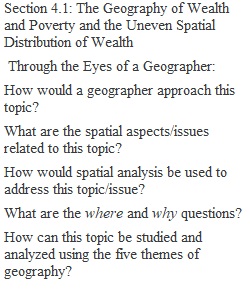


Q Section 4.1: The Geography of Wealth and Poverty and the Uneven Spatial Distribution of Wealth Through the Eyes of a Geographer: How would a geographer approach this topic? What are the spatial aspects/issues related to this topic? How would spatial analysis be used to address this topic/issue? What are the where and why questions? How can this topic be studied and analyzed using the five themes of geography? Overview: There is great spatial variation in the distribution of wealth at all scales from local to global. At a global scale, geographers are interested in where rich and poor countries are located why they became rich and poor. There are complex reasons behind this uneven distribution of wealth. Many of these causes focus on colonialism, exploitation, control of resources, and different political and economic systems. Although life in highly developed countries is typically more comfortable for most people, wealthy countries face many problems and challenges that stem from the highly uneven distribution of income and abundance. Critical Thinking/Discussion Questions: 1. What is development? How are different levels of development measured? What conditions make a country rich or poor? 2. Where are the more developed countries located, and where are the less developed countries located? Why are there rich and poor countries? What are the reasons contributing to the uneven spatial distribution of wealth? 3. Are there disadvantages to living in a society with high levels of development? Are there advantages to living in a society with low levels of development? What social and cultural changes occur as societies undergo transitions from lower to higher levels of economic development? Practice Questions (Write Correct Answer in Blank): Multiple Choice: 1. ___ Of the world’s population, about ____ % live in developed countries (MDC) and _____ % live in developing countries (LDC): A) 40; 60 B) 55; 45 C) 10; 90 D) 20; 80 2. ___ Wealth is distributed unevenly throughout the world and this country. In the U.S., __ % of the population owns __ % of the wealth: A) 25; 70 B) 2; 90 C) 70; 40 D) 12; 82 3. ___ During the last 110 years, the U.S. population has made a transition from an ____/____ society to a _____/_____ society: A) gentrified/primary; gentrified/secondary B) consumer/open; producer/closed C) inward/industrial; outward/industrial D) rural/outdoor; urban/indoor 4. ___ These two events illustrate how developed societies pay for services that are traditionally carried out by the family: A) transportation and birth planning B) education and counseling C) animal slaughter and dead body preparation D) religious ceremony and clothing production 5. ___ The process of improvement in the material conditions of people through the diffusion of knowledge and technology is called: A) politics B) development C) culture D) assimilation True or False: 1. ___ The spatial distribution of resources is even throughout the world. 2. ___ Due to advances in technology, most Americans state that they have more leisure time than ever before. 3. ___ All developing countries share the common characteristic of possessing relatively few natural resources. 4. ___ Only two-thirds of all developed nations have experienced an industrial revolution. 5. ___ Two of the most common measures of the level of economic development are production and consumption.
View Related Questions